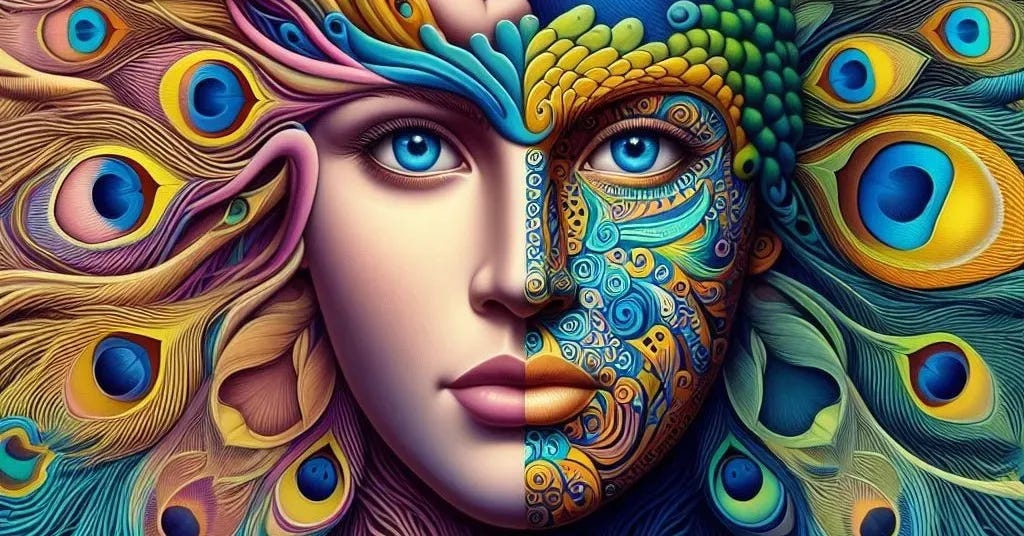Human Equivalents of the Peacock's Tail
How mutual mate choice shaped human evolution
Mutual Mate Choice:
A situation in mating interactions where both sexes actively and simultaneously choose their partners based on specific traits or characteristics, rather than one sex being selective while the other is indifferent or non-discriminating in its choice.
Humans are animals. In some ways, we’re very similar to our nonhuman cousins. In other ways, we’re very different.
One way that we’re different is that humans, unlike most species, have what’s called mutual mate choice.
In most species, females alone are choosy about their mates, and their mate preferences shape the evolutionary trajectory of the males.
The classic example is the peacock’s tail: Over many generations, the female preference for a mate with a larger-than-average, more colorful-than-average tail created a selection pressure that led to the evolution of increasingly extravagant tails in the males.
Humans, however, play by a different set of rules.
In our species, both sexes are choosy about their mates, at least when it comes to long-term, committed relationships. This means that not only do women shape the evolution of men’s traits, but men shape the evolution of women’s.
As a result, Homo sapiens is a species in which both sexes have their equivalents of the peacock’s tail, rather than only the males.
The most obvious human peacock’s tails are physical traits that appear at puberty, and that people find attractive in members of their preferred sex.
But our evolutionary ornaments aren’t limited to looks. Humans also have various psychological peacock’s tails, including kindness, humor, and creative intelligence - traits that enhance mate appeal beyond the purely physical.
The fact that we’re a species with mutual mate choice traces back to the fact that our offspring are biologically very costly to rear. Human infants are completely helpless at birth and take longer than the young of any other species to reach nutritional independence.
Unlike most female apes, female humans can’t do it alone. Thus, our species evolved various forms of allomaternal care - that is, care from individuals other than the mother. Often, this care comes from the father in the context of a long-term pair bond.
But fathers couldn’t have evolved to fall in love, form pair bonds, and invest in their young without also evolving to be choosy about their long-term partners: about as choosy as women are.
And that, ultimately, is why we evolved our strange system of mutual mate choice — and our his-and-hers peacock’s tails.
This article was written by Steve Stewart-Williams; Professor of psychology and author of The Ape That Understood the Universe (2018) and Darwin, God and the Meaning of Life (2010).
I hope you enjoyed this dive into the quirks of human mate choice. If you did, I’d love to have you join me on my own Substack for more psychology, evolution, and science!
Further Reading
I explored mutual mate choice in my last book, The Ape That Understood the Universe, and I’ll be digging deeper into the topic in my next book, A Billion Years of Sex Differences (formerly The Peacock’s Predicament).
Many of my academic publications also deal with mutual mate choice and the nature of human sex differences. They’re all available for free on ResearchGate. Here are some of the main ones:
Stewart-Williams, S. (2020). Are humans peacocks or robins? In L. Workman, W. Reader & J. Barkow (Eds.), Cambridge Handbook of Evolutionary Perspectives on Human Behavior (2nd ed., pp. 342-352). Cambridge University Press. https://doi.org/10.1017/9781108131797.029
Stewart-Williams, S., & Thomas, A. G. (2013). The ape that thought it was a peacock: Does evolutionary psychology exaggerate human sex differences? Psychological Inquiry, 24, 137-168. https://doi.org/10.1080/1047840x.2013.804899
Stewart-Williams, S., & Thomas, A. G. (2013). The ape that kicked the hornet's nest: Response to commentaries on “The Ape That Thought It Was a Peacock”. Psychological Inquiry, 24, 248-271. https://doi.org/10.1080/1047840x.2013.823831
Finally, here’s an essay I published on my Substack last year about the evolution of human sex differences:





